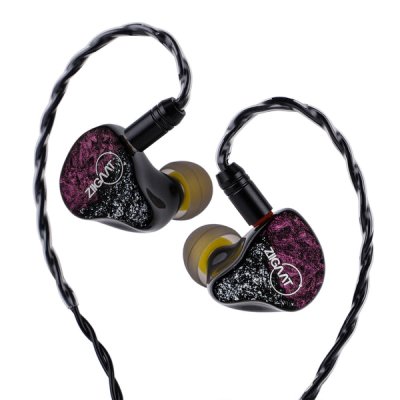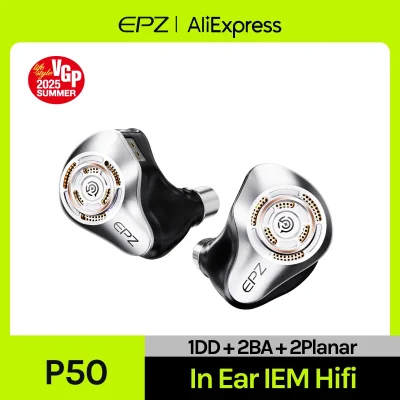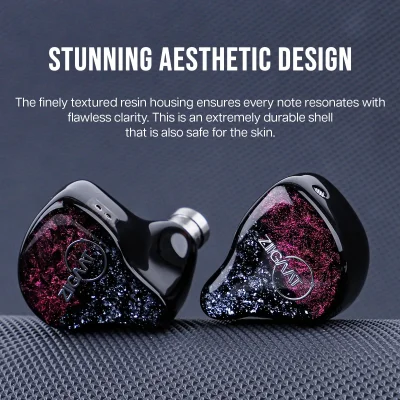Ziigaat Odyssey and EPZ P50 use 1DD+3BA and 1DD+2BA+2Planar driver setups respectively. Ziigaat Odyssey costs $229 while EPZ P50 costs $205. Ziigaat Odyssey is $24 more expensive. Ziigaat Odyssey holds a clear 0.5-point edge in reviewer scores (7.7 vs 7.2). User ratings place Ziigaat Odyssey at 7.4 and EPZ P50 at 9.5. EPZ P50 has better bass with a 0.6-point edge, EPZ P50 has slightly better treble with a 0.3-point edge and Ziigaat Odyssey has better dynamics with a 0.5-point edge.
Insights
| Metric | Ziigaat Odyssey | EPZ P50 |
|---|---|---|
| Bass | 7.5 | 8.1 |
| Mids | 8.3 | 8.2 |
| Treble | 7.3 | 7.7 |
| Details | 7.7 | 8.3 |
| Soundstage | 7.5 | 7.6 |
| Imaging | 7.7 | 8.4 |
| Dynamics | 7 | 6.5 |
| Tonality | 7.8 | 7.3 |
| Technicalities | 7.1 | 7.3 |
Ziigaat Odyssey Aggregated Review Score
Average Reviewer Scores
Average Reviewer Score:
7.7Strongly Favorable
EPZ P50 Aggregated Review Score
Average Reviewer Scores
Average Reviewer Score:
7.2Generally Favorable
Reviews Comparison
Ziigaat Odyssey reviewed by Jaytiss
Youtube Video Summary
Single-DD + 3BA hybrid with a clean, confident look: thick shell, metal nozzle that grips tips well, visible rear vent, and the preferable flat 2-pin connector. The standard Ziigaat case feels premium if a bit unexciting. Sonically, Odyssey lands a balanced, tastefully energetic tuning—ample bass for most listeners, elevated upper mids for presence, and a smooth, clean upper-treble. Out of the box it sounds immediately right and counts among the better-tuned sub-$300 IEMs. The catch: macro/micro detail and imaging are good, not mind-blowing, keeping overall technical performance at “appropriate for the price.”
Within Ziigaat’s lineup, Arcadia skews darker with less treble reach, Xeno/Ceno feels a bit treble-shy, and Dinko is the more V-shaped, poppier pick with extra sub-bass. Explorer overlaps in tonality but Odyssey adds more upper-mids energy and refinement—albeit at a higher price. Among peers, AFUL’s P7 brings the stronger technicals and a slightly more neutral sheen, K4 trades blows, and “Quattro” may edge tuning purity. As an all-rounder, though, Odyssey hits a sweet spot: rich mids, fun but controlled bass, convincing note weight, and a natural stage, even if the far-upper air can temper ultimate sparkle.
Verdict: a fantastic mid-tier set with high price-to-performance, gorgeous faceplates, and a crowd-pleasing tonality; accessories are a bit underwhelming, and the top-end “air” won’t wow technicality chasers. Scored around 8.8/10 and easily recommended as a safe, musical choice—especially when discounts bring the sticker down.
Jaytiss Youtube Channel
Buy Ziigaat Odyssey on Linsoul
Ad
Price: $229
Buy Ziigaat Odyssey on Linsoul
EPZ P50 reviewed by Jaytiss
Jaytiss Youtube Channel
Buy EPZ P50 on Aliexpress
Ad
Price: $199
Buy EPZ P50 on Aliexpress
Ziigaat Odyssey reviewed by Audio Amigo
Youtube Video Summary
Ziigaat Odyssey comes in at $230 with a four-driver hybrid (1DD + 3 BAs) that’s very easy to drive. Build is the usual Ziigaat: full 3D-printed resin shells with metal nozzles and filters; sturdy and comfortable for average-to-larger ears, while tiny ears get a technical pass. The weak spot is the accessories: a basic cable (3.5mm or 4.4 option), one set of soft silicone tips plus foams, and a leatherette case that feels flimsy—underwhelming at this price. Aesthetics score well with a sparkly faceplate that the “Council of Ladies” mostly favors, even if it doesn’t always trigger compliments.
Sonically, Odyssey aims for warm-neutral with a tasteful bass boost. Sub-bass texture can run a touch soft, but mid-bass punch is addicting, giving kick drums and bass guitars real drive without boom. Lower mids are warm and slightly veiled in a pleasant, retro-leaning way; female vocals sit a bit back yet remain clean. Treble is safe but present—enough sparkle and clarity to balance the bass without sting, though true treble-heads may want more air. Technicals are solid for the bracket: good resolution, excellent separation, precise imaging, and an average-sized but convincing stage. With a 15–30Ω adapter, the FR tilts more V-shaped (more bass/upper-mids/treble), a fun twist for occasional variety.
Against peers, Odyssey is the relaxed, safer listen: warmer and less contrasty than EPZ P50 (brighter, more vocal-forward) and Kiwi Ears K4 (more V-shaped excitement), and a middle ground between AFUL Explorer (darker, bassier) and AFUL Performer 5+2 (airier, more resolving with stronger female vocals). Not the pick for bass-heads, treble-heads, or libraries packed with K-/J-pop divas, but a killer one-and-done all-rounder for mixed libraries that value warmth, balance, and zero fatigue. Despite the skimpy pack-ins, the tuning and performance earn a spot in “this is brilliant.”
Audio Amigo Youtube Channel
EPZ P50 reviewed by Audio Amigo
Youtube Video Summary
EPZ P50 comes as a tribrid at $185 with a surprisingly complete kit: a sturdy leatherette case, modular 3.5/4.4mm terminations, three silicone tip sets, and a cleaning cloth. The resin shells are semi-custom with aluminum faceplates; comfort is generally good but anatomy-dependent, and the stock cable—while well finished—runs on the stiff side. A standout twist is the factory customization option (~$225 total for the “Grindphones” style), which notably doesn’t alter the tuning in any meaningful way. The set is easy to drive, shows minimal change with impedance adapters (a touch warmer/more vocal-forward), and avoids pressure issues thanks to smart internal venting.
Sonically, tuning sits as a controlled, mild V: bass is just north of neutral with pleasing texture and impact, mids stay clean with an engaging female-vocal emphasis, and treble adds airy sparkle without turning tizzy—though insertion depth can trigger length-mode variability for some ears. Technical chops impress at the price: detail retrieval punches up, imaging is precise with good separation, and stage reads average but coherent. Against peers, P50 feels more resolving than Kiwi Ears K4 (trades bigger bass/sparkle for better mid clarity), brighter and more vocal-present than the neutral-leaning Ziigaat Lush, and echoes a Dunu Da Vinci vibe with less bass. Verdict: tremendous value and a terrific pick for vocal-centric libraries—highly recommended to audition first if treble sensitivity or fit quirks are a concern.
Audio Amigo Youtube Channel
Ziigaat Odyssey reviewed by Jays Audio
Youtube Video Summary
Ziigaat Odyssey lands as a mid-range focused set with a slight treble lift that really scales with volume. At relaxed levels it’s clean, calm, and easygoing; turn it up and the presentation becomes wide, airy, and immersive with a surprisingly punchy, rumbly low end for its graph. The new topology DD hits a sweet balance—neither sluggish nor hyper-snappy—delivering well-balanced bass that serves the tuning, even if ultimate slam/texture trails sets like Hype 4 or Xenns Tea Pros. Tip rolling toward slightly brighter tips adds a touch of treble energy and liveliness without pushing fatigue.
The star here is the midrange: instruments layer neatly with comfortable separation, and vocals sit clean and natural—not shouty, not veiled—though they can feel a bit too relaxed at mid volume. Treble is smooth yet detailed, revealing cymbal micro-info and air without harshness, and it’s noticeably cleaner than Explorer while avoiding metallic timbre. Technicals are solid for the price—a step up from Explorer and just behind “contet” in raw resolving power—yet more natural in timbre and notably more musical when driven louder. The tuning flatters slow rock, acoustic, indie, alternative, and ballads, where the Odyssey’s “turn-it-up” character shines.
For alternatives: those wanting warmer, bassier impact for hip-hop, rock, or metal may prefer Kiwi Ears K4, HBB Arcadia, or the Deuce for true bass-head needs. For mid-volume all-rounders with more instant engagement and technical pop, consider Supermix 4, Nova, Quintet, or Chopin; for airier, brighter takes with sweeter female vocals, look at Cadenza 4 or CKLVX. As a package, Odyssey feels like a future classic—gorgeous plating, a cable that could use an upgrade, and a uniquely immersive, high-volume experience that invites shutting out the world and sinking into the music.
Jays Audio Youtube Channel
EPZ P50 reviewed by Jays Audio
Youtube Video Summary
The EPZ P50 comes in hot as a new tribrid and a potential $200 neutral benchmark, trading sterile restraint for a more vocal-centric presentation. Versus the MEGA5EST, vocals sit a touch more forward—adding emotional weight and clarity—while the MEGA5EST still edges it on sheer smoothness and EST “air.” Compared to Meteor, the P50 fills in the lower mids, dials back 1–3 kHz glare, and opens the top end a bit; Meteor stays a hair softer up top. The catch is bass: the P50’s DD is competent but not a sub-bass shaker—expect clean rather than authoritative slam.
Against peers, the P50 sounds fuller and more natural than Supermix 4 (which is brighter and more “hi-fi” energetic), and it trades blows with Odyssey: Odyssey brings better bass texture and treble micro-detail, while the P50 delivers superior vocal clarity and a touch more air. It excels at mid-volume listening—Volume S needs more gain to bloom—and outclasses lighter, air-tilted sets like “K4” style tunings when male vocals or body are the priority. Accessory game is strong too: a nicer cable and a genuinely sturdy hard-leather case sweeten the deal. Not the most “unique” flavor and not for bassheads, but as a balanced, clean, vocal-forward option around $200, P50 is an easy recommendation for those chasing neutrality without the vanilla.
Jays Audio Youtube Channel
Ziigaat Odyssey reviewed by Tim Tuned
Youtube Video Summary
Ziigaat Odyssey takes the new Meta tuning and gives it a more V-shaped, exciting twist. It keeps the beautiful mid-range intact while adding extra energy to both bass and treble, landing closer in spirit to Moondrop x Crinacle Dust (DSP) and Kiwi Ears K4—but with more swagger. It’s not as strictly on-target as those sets, yet the result is more engaging and solves the “too safe, sometimes boring” side effect of many Meta-tuned IEMs.
Beyond tuning, Odyssey brings real upgrades in technical performance for the price. Bass dynamics are punchier and more well-defined than K4, and treble nuances come through with greater clarity while preserving that natural vocal center. At $229, it undercuts many competitors and still feels like a step up—an easy pick for listeners who want Meta’s mid clarity with extra excitement and better slam without sacrificing coherence or comfort.
Tim Tuned Youtube Channel
EPZ P50 reviewed by Tim Tuned
Tim Tuned Youtube Channel
Ziigaat Odyssey reviewed by Gizaudio Axel
Gizaudio Axel original ranking
Gizaudio Axel Youtube ChannelEPZ P50 reviewed by Gizaudio Axel
Ziigaat Odyssey reviewed by Head-Fi.org
EPZ P50 reviewed by Head-Fi.org
Ziigaat Odyssey reviewed by Web Search
The Ziigaat Odyssey offers a balanced take on the popular Meta tuning, emphasizing sub-bass rumble while maintaining a clean midrange. Its bass provides satisfying depth without bleeding into the mids, making genres like electronic or hip-hop engaging. Vocals come through clearly and naturally, though some listeners might find them lacking a touch of emotional expressiveness or "magic" compared to more specialized sets . The treble is generally smooth and inoffensive, avoiding harshness but sacrificing some sparkle and micro-detail retrieval .
Technically, the Odyssey presents a wider-than-average soundstage, though depth and height are more modest. Instrument separation handles moderately complex tracks competently but can struggle with dense passages. Its strength lies in its cohesive driver integration and natural timbre, minimizing typical BA artifacts . Comfort is good for most despite the resin shells, but isolation is average due to the venting design. The included accessories, particularly the stiff silicone tips and non-modular cable, are weak points for the price .
Overall, the Odyssey is a versatile performer prioritizing enjoyable tonality and listenability over technical brilliance. It's an easy recommendation for those seeking a well-tuned, non-fatiguing hybrid around $200, especially if tip rolling is employed. However, detail enthusiasts or those needing maximum isolation might look elsewhere .
EPZ P50 reviewed by Web Search
2025-10-03The EPZ P50 is a tribrid with a 10 mm dynamic driver, two balanced armatures, and two micro planar drivers, implemented in a semi-open back shell and a three-way crossover—an uncommon configuration at this price tier. Listings and spec sheets place impedance at 20 Ω and sensitivity around 106 dB, with interchangeable 3.5/4.4 mm plugs and 0.78 mm 2-pin connectors, positioning it as a flexible daily-carry IEM near the $200 mark.
Subjectively, multiple reviews converge on a neutral-with-bass-boost presentation: sub-bass is tight and weighty when called for, mids stay clear and slightly forward, and treble is extended with extra energy from the planar tweeters. This yields a clean center image and articulate vocals without obvious mid-bass bloom, though the upper-treble emphasis can read “sharper” on some recordings.
Technical performance is competitive for the class: reviewers note solid imaging, above-average separation, and a stage that feels wider than typical sealed IEMs—qualities plausibly aided by the semi-open design and multi-way damping. Trade-offs include reduced isolation versus closed shells and a treble tilt that may fatigue treble-sensitive listeners at high volumes, but overall resolution and micro-detail retrieval punch above its price.
Ziigaat Odyssey (more reviews)
Ziigaat Odyssey reviewed by Bad Guy Good Audio
Bad Guy Good Audio original ranking
Bad Guy Good Audio Youtube Channel
Ziigaat Odyssey reviewed by
 Fresh Reviews
Fresh Reviews
Youtube Video Summary
Ziigaat’s 2024 lineup lands three distinct flavors: the R (1DD+4BA), Arcadia (1DD+2BA), and Odyssey (1DD+3BA)—all sharing the same case, tips, and cable, but with very different tunings and striking faceplates. Pricing lives in the approachable range (roughly $200–$250), and the shells are well-built 3D-printed resin. The Odyssey’s nozzle appears slightly wider than the R’s, and its cloudy pink/silver faceplate looks clean and premium without the flashiness of Arcadia’s green/yellow sparkle.
For competitive play, title-by-title differences matter. In Valorant, Arcadia’s extra warmth and bass impact feel immersive but a touch boomy/bloomy under heavy ability spam—solid, around a B. The R and Odyssey perform on par with high marks; the R’s 1–3 kHz lift sharpens clarity and verticality, while Odyssey is more neutral and less bright. In Apex Legends, Arcadia struggles as bass bloom masks micro-cues (B–/C+). Odyssey delivers great separation/layering with slightly softer overhead cues (B+/B), and handles gunfire more comfortably than the R. In CS2, Odyssey takes the lead for its imaging, depth perception, and non-fatiguing balance; in Warzone, the order shifts to R > Arcadia > Odyssey, with Arcadia’s warmth helping vertical reads and impact.
As a music set, the Odyssey is a standout: potent, tight bass with clean transients, balanced mids that aren’t smothered, and a clean, non-sibilant treble that avoids fatigue while letting micro-detail through. It lands as a favorite in its price bracket—an easy recommendation for listeners who want a neutral-leaning all-rounder that still punches hard, splits cues well, and won’t scorch ears with gunfire or treble glare.
Fresh Reviews original ranking
Fresh Reviews Youtube ChannelEPZ P50 (more reviews)
EPZ P50 reviewed by Super* Review
Youtube Video Summary
EPZ’s P50 feels like a breakout for the brand: a compact, medium-small shell with a vented faceplate that’s marketed as “open-back,” yet isolates like a typical IEM. The unboxing is tidy at this price—carry puck, a real microfiber cloth, and two sets of generic tips—while the modular cable (screw-lock swappable termination) is handy if a bit thin, stiff, and kink-prone; the 2-pin plug sits slightly proud of the socket and the “R” marking is visible on the outside. The long nozzle (~5.5 mm diameter) can push fit depth, so shorter tips (e.g., NF Audio-style) help; once set, stability and comfort are excellent. Overall build looks clean and modern, if a touch editorial compared with EPZ’s other shells.
Sonically, P50 embraces the current tilted diffuse-field “new meta” with a mostly neutral, natural presentation and a later-rising, sub-bass-centric lift that gives bounce rather than mid-bass thump. There’s a hint of extra presence around the 4–5 kHz region that adds macro-contrast—vocals pop with definition and separation is crisp—while upper treble stays safe: cymbals are clean but a bit light in weight. Bass is tight and incisive rather than slammy; micro-texture on vocals is good, though the set favors that big, “stagey” contrast over ultra-fine grain. It’s easily EPZ’s best tuning so far: clear, organized, and engaging without drifting from neutral-ish aims.
Against peers, Kiwi Ears K4 tracks a similar target but sounds lower-contrast and can blur on dense mixes; P50 hits harder on transients, images more cleanly, and keeps busy tracks sorted, while K4 offers a richer midrange with “frothier” treble. Versus the Binary Chopin, Chopin is warmer, fuller, and more mid-bass driven—more “analog” and atmospheric—with deeper perceived space but a bulkier fit; P50 is leaner, clearer, and the least bass-forward of the three. Verdict: a confident 4/5 for delivering a small, comfy fit and a clean, contrasty neutral that competes squarely around $200–$250. If the brief is “neutral with a bit of drama,” this is a strong pick—and a promising sign of where EPZ can go next.
Super* Review original ranking
Super* Review Youtube ChannelEPZ P50 reviewed by Kois Archive
Youtube Video Summary
The EPZ P50 arrives as a ~$200 tribrid with a slick presentation: FR graph on the box, a puck-style case, plenty of tips (oddly two identical sets), and a nice microfiber cloth. Build leans premium with a semi-open back and a faceplate that gives “arc reactor” vibes. The custom shell offers a secure fit for most, though very small ears—or anyone sensitive to an inner wing—may need caution. The modular cable (3.5/4.4 mm) is practical yet slightly stiff and retains some memory; isolation is typical of sealed IEMs despite the semi-open styling.
Sonically, the P50 goes for a warm-balanced tuning. Bass quality impresses: bouncy with deep sub-bass reach, prioritizing texture and control over sheer quantity (more thump is possible via an impedance adapter). Mids read natural with a touch of warmth—male vocals shine—while female vocals can feel a bit lean due to a more relaxed upper-mid energy. Treble is smooth, inoffensive, and “planar-clean” without planar timbre, with only a slight wish for more top-end extension.
Technical performance is the star. The micro planars pull out micro-detail unusually well for the price; imaging, separation, and overall resolution feel confidently executed, making guitars pop and busy mixes easy to parse. That clarity translates to gaming, where positional cues and crowded soundscapes (think battle royale chaos) remain intelligible—worthy of a two-controller gaming nod. Overall, the EPZ P50 is a solid contender at this price: balanced tuning with standout detail retrieval and imaging, tempered only by mids that play it a little safe. For listeners unbothered by a gentler upper-mid lift, it’s well worth the money—a two-star recommendation.
Kois Archive Youtube Channel
Ziigaat Odyssey Details
Driver Configuration: 1DD+3BA
Tuning Type: Neutral with Bass Boost
Brand: ZiiGaat Top ZiiGaat IEMs
Price (Msrp): $229
Support our free service! Buying through our affiliate links costs you nothing extra:
EPZ P50 Details
Driver Configuration: 1DD+2BA+2Planar
Tuning Type: Neutral with Bass Boost
Price (Msrp): $205
Support our free service! Buying through our affiliate links costs you nothing extra:
Ziigaat Odyssey User Review Score
Average User Scores
Average User Score:
Based on 2 user reviews
7.4Generally Favorable
EPZ P50 User Review Score
Average User Scores
Average User Score:
Based on 1 user reviews
9.5Exceptional
Ziigaat Odyssey Gaming Score

Gaming Score & Grade
- The gaming score is prioritizing technical capabilities of the IEM (Separation, Layering, Soundstage) and good value.
Gaming Score
7.5Gaming Grade
AEPZ P50 Gaming Score

Gaming Score & Grade
- The gaming score is prioritizing technical capabilities of the IEM (Separation, Layering, Soundstage) and good value.
Gaming Score
7.3Gaming Grade
A-Ziigaat Odyssey Scorings
Average Technical & Tuning Grades
Average Tunign Grade
A- You get a polished tonal profile that stays natural from bass through treble. Subtle tuning choices keep things engaging.
Average Technical Grade
A-- A competent technical showing keeps separation intact while delivering modest staging. It feels tidy even when recordings stack layers.
EPZ P50 Scorings
Average Technical & Tuning Grades
Average Tunign Grade
A-- The tonal character feels settled and versatile, with just a few gentle bumps. You can listen for hours without fatigue.
Average Technical Grade
A-- You get a controlled, composed performance, marrying decent clarity with a still-modest sense of space. A safe technical performer for the price bracket.
Ziigaat Odyssey User Reviews
Share your experience and build your personal ranking list.
You need to be signed in to write your own reviewVery pleasing to listen to. A good starter mid-fi set that seems to cater towards neutrality while decently technical. Sibilance at higher volumes in the 6-8khz region. Good for gaming, but can get convoluted at times.
Pros
Extremely smooth mids. Bass response is very clean, and doesn't bleed into the mids much.Cons
Strange sibilance in the 6-8khz region, easy fix with eq. Doesn't seem to have very good treble extension. The recessed 1.5-2khz region causes vocals to sound distant - can be good depending on preferences.It's an easy recommendation. The tuning is great. Tech is okay, but nothing special
Pros
Fun but still "accurate" sounding signature. Comfy shell with nice design.Cons
The cable requests to be replaced. Nothing special in terms of technicalities.EPZ P50 User Reviews
Share your experience and build your personal ranking list.
You need to be signed in to write your own reviewKillabuck.
Pros
No roughness, Natural timbre, Balanced signature, good note density, Very good consistency, comfortable to use, Good cable, Technically amazing, good accessories, good tips, good transparency, good brightness, tactile bass, not much warmth, nice voices.Cons
None.Find your next IEM:
IEM Finder Quiz
newIEM Comparison Tool
newVS
























